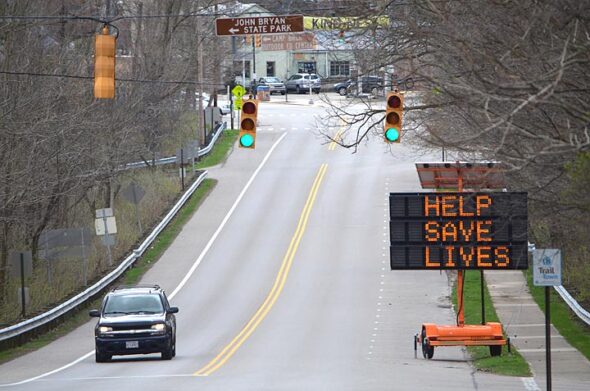
In early April 2020, the Village of Yellow Springs erected three electronic signs with public messaging at the gateways to town in an attempt to inform, and also deter visitors during the statewide “stay-at-home” order. After a throng of tourists visited the prior week, some flaunting social distancing rules, the Village, Glen Helen and the Chamber discouraged visitors. (Photo by Megan Bachman)
A village and a virus, four years on
- Published: April 11, 2024
Matthew Huntington loved Dungeons and Dragons. He played bass clarinet in the Yellow Springs Community Band and Orchestra and in high school, he ran track and excelled in his coursework. His former classmates remember him as a quiet, but kind presence.
On April 18, 2020, Huntington, aged 50, was the first Yellow Springs resident to die from COVID-19.
This year marks the fourth anniversary since the novel coronavirus began spreading uncontrollably throughout the world, shuttering businesses, upending routines, overwhelming hospitals and ultimately claiming the lives of over 1 million U.S. residents — lives of friends, parents, children and kind people, just like Matthew Huntington.
But now, four years after the initial outbreak, COVID-related illnesses, hospitalizations and deaths are trending downward globally.
According to the most recent data from the Centers for Disease Control and Prevention, or CDC, nationwide positive tests and hospital admissions have declined by 0.8% and 20.9% respectively in the last week. Locally, this week is the fourth consecutive week Greene County had a “low” level for new COVID-19-related hospital admissions, with 6.7 new hospitalizations per 100,000 population.
Almost a year ago, in May 2023, Dr. Bruce Vanderhoff, director of the Ohio Department of Health, or ODH, declared in an online press conference that the federal COVID-19 health emergency had ended, but noted that such a declaration “does not mean COVID is over or no longer a public health concern.” In a more recent public statement last month, Dr. Vanderhoff appeared to treat COVID-19, RSV and influenza with equal concern.
“Fortunately, our COVID-19 and RSV numbers have both declined from the levels that they had reached in January,” Dr. Vanderhoff said last month. “We were seeing 10,000 or 12,000 COVID-19 cases a week earlier this year. We’re now down to about 7,000 cases.”
The decline has continued. Last week, there were 2,719 reported cases in Ohio.
Still, despite these promising trends, the effects of the COVID-19 global pandemic continue to ripple — even in Yellow Springs. Local lives have been lost. As of this week, a total of 475 of our Greene County neighbors have died from COVID-19 since the start of the pandemic four years ago.
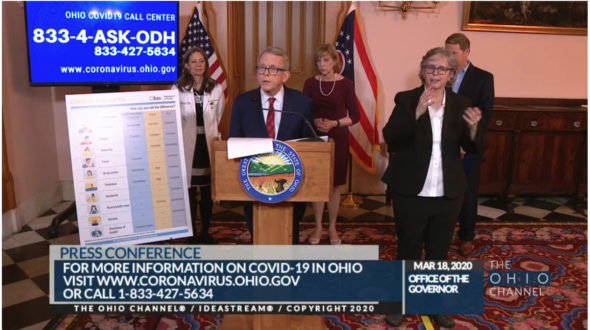
Video still from Gov. DeWine’s March 18 briefing
The early days
Three months after the first known case of the coronavirus disease, caused by the virus SARS-CoV-2, was identified in Wuhan, China, in December 2019, the World Health Organization declared the outbreak a worldwide pandemic on March 11.
Two days prior, on March 9, Ohio declared a state of emergency after its first confirmed case of COVID-19, followed by the U.S. on March 13 and Greene County on March 17.
Fears of the virus quickly swept over Yellow Springs that month, and the social landscape of the village changed dramatically. On those sunny spring days, when downtown would normally be awash in commerce and chit-chat from villagers and visitors alike, the streets and sidewalks were almost entirely silent.
Most Ohioans were forced indoors and stayed home, following a March 23 order from Gov. Mike DeWine and former ODH Director Amy Acton.
“We haven’t faced an enemy like we are facing today in 102 years,” DeWine said — referring to the deadly Spanish flu — in a press conference that month. “We are at war. In the time of war, we must make sacrifices.”
Ohio pre-K through 12 schools — both public and private — closed down; visitors were barred or restricted from hospitals and correctional facilities; and nearly all in-person Alcoholics Anonymous, musical, spiritual and religious gatherings were canceled.
Local institutions such as the Senior Center, The Riding Centre, Antioch College’s Wellness Center, the library and others closed to the general public. Some businesses, such as Unfinished Creations, Benzer Pharmacy (now Yellow Springs Pharmacy), Highlander Laundromat, Yellow Springs Hardware, Tom’s Market, Nipper’s Corner, Dollar General and Starflower Natural Foods remained open under state exemptions for “essential businesses.”
The News also never ceased operations throughout the pandemic, and even mailed four, free-of-charge issues to all households in the 45387 zip code, in an effort to keep local residents informed of COVID-related developments in Yellow Springs.
While all bars, coffee shops and restaurants were ordered to close their dining areas, several shifted their operations and began offering delivery and/or carry-out. Yellow Springs Brewery, Calypso Grill and Current Cuisine were among those that began delivering food and drinks to local residents.
Despite those few businesses that continued operations, nationwide unemployment peaked at an unprecedented level in April 2020, climbing to 14.8%, according to data from the U.S. Bureau of Labor Statistics. Some economic relief came in the form of the Coronavirus Aid, Relief and Economic Security, or CARES, Act, which included sending a stimulus check for $1,200 to every adult, expanded unemployment benefits and more.
For those workers and residents who did venture out of their homes, behavior also changed. People wore masks, were encouraged to stay six feet apart from one another — practicing what was initially called “social distancing,” then later “physical distancing,” by state officials — and frequently scrubbed their hands and sometimes their groceries with sanitizer.
Locally, sewing-machine-wielding villagers mobilized a large effort to provide face masks for those in the community and surrounding areas who work daily in the village’s public eye.
In quarantine, people got hooked on Wordle and became all-too acquainted with Zoom meetings; many amateur bakers were born and anecdotally, local gardens had never looked better.
Governance continued, albeit in different ways.
For many weeks, Gov. DeWine held daily press briefings from the statehouse in Columbus, updating Ohioans on the status of the spread of COVID-19 and the state’s response. Often, former ODH Director Acton discussed the need to “flatten the curve” on the spread of the virus.
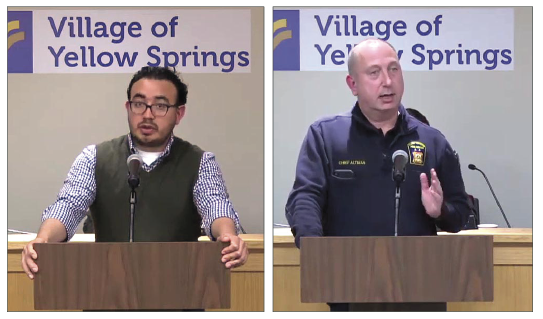
Former Yellow Springs Village Manager Josué Salmerón, left, and former Miami Township Fire Chief Colin Altman shared what their departments were doing to safeguard employees while continuing services for villagers during a “virtual town hall” broadcast and streamed on March 16, 2020. (Video stills from YouTube)
In Yellow Springs, former Village Manager Josué Salmerón, members of Village Council, former Miami Township Fire-Rescue Chief Colin Altman and others also held virtual briefings, updating villagers on the municipal response to the virus’ spread, local closures and more. Council meetings continued to be held virtually until early 2022.
Of Village Council’s most significant COVID-related legislation passed during the pandemic were declaring a local state of emergency via a resolution, as well as codifying an ordinance that mandated facial coverings downtown and on Village-owned properties when physical distancing of six feet was not possible.
Also early in the pandemic, the Village erected three electronic signs with public messaging at the gateways to town in an attempt to inform, and also deter visitors during the statewide “stay-at-home” order. In the village’s history, it was one of the only instances of Yellow Springs turning away tourism.
Symptoms and solutions
Case loads continued to rise and the pandemic worsened.
By April 10, 2020, with over 18,600 confirmed deaths and more than 500,00 confirmed cases in under four months, the U.S. became the country with the most reported COVID-19 cases and deaths, surpassing Italy and Spain as a global hotspot for the virus. And by September that year, there were over 1 million COVID-related deaths worldwide.
The pandemic peaked mid-December 2020, and by the following year, just before the first anniversary of the first case in the village, 245 residents of the 45387 area code, which includes Yellow Springs and the surrounding rural area, had contracted the virus. That equated to one out of every 22 people living here.
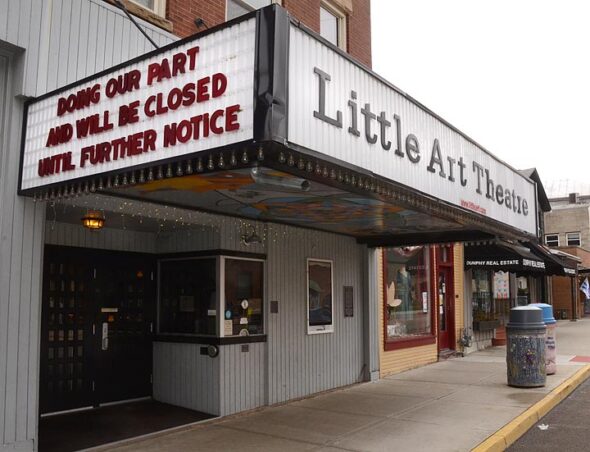
Many downtown shops closed or changed their operations to help slow the spread of COVID-19. (Photo by Matt Minde)
“I thought there was some reasonable chance I was not going to make it,” villager Bruce Heckman told the News in February 2021.
Heckman said he contracted the novel coronavirus after a visit to a physical therapist’s office, where masks didn’t prevent the transmission in an enclosed office.
“My advice is, you really, really, really don’t want to get this virus,” Heckman said then.
As Heckman could attest, COVID-19 symptoms are unpleasant. People often lose their sense of smell and taste, and typically experience fevers, chills, coughing, shortness of breath or difficulty breathing, fatigue, aches and more. In the worst cases, COVID patients were intubated and placed on mechanical ventilators to help them breathe.
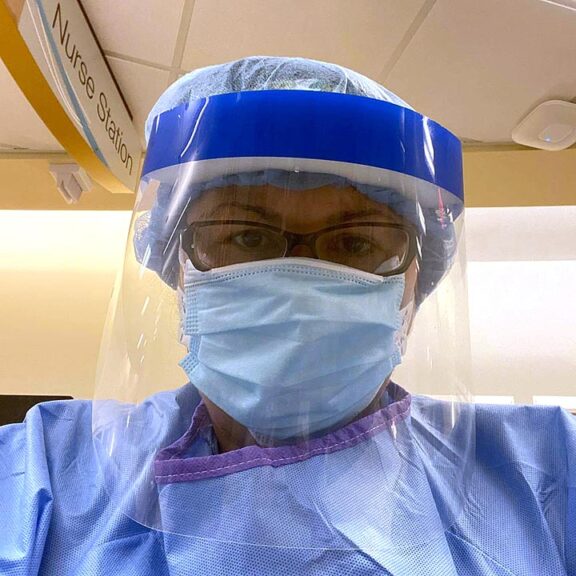
Yellow Springs resident Chasilee Crawford is an ICU, or intensive care unit, nurse at Springfield Regional Medical Center. She volunteered to work in the hospital’s designated COVID-19 specific ICU when it was formed March 2020. (Submitted photo)
“Patients are so fragile,” Yellow Springs resident and intensive care unit nurse Chasilee Crawford told the News at the height of COVID. “One minute they can be fine, and the next minute, they need a ventilator.”
A glimmer of hope eventually came in the form of vaccines.
At the beginning of 2021, the elderly residents at Friends Care Community were some of the first Yellow Springers to receive the first round of COVID-19 vaccines. By April, most of the general population was eligible for the Moderna, Pfizer and Janssen vaccines.
While many pharmacies began administering these free vaccines, some local residents received their shots in unusual places, such as a pop-up clinic in a former JC Penny in Springfield.
According to recent CDC data, approximately 65% of Greene County residents have received at least one COVID-19 vaccine since the initial 2021 roll-out. That’s lower than the 81% nationwide vaccination rate.
Most recently, fewer than 14% of U.S. residents have reported receiving the updated 2023–24 COVID-19 vaccine.
As evidenced by these statistics, not everyone was happy with the CDC recommendation to get vaccinated. In November 2020, several protests were staged in front of Gov. DeWine’s Cedarville home. The message from the hundreds who assembled was clear: Eschew vaccines, cease the mandatory mask mandate and end the statewide curfew.
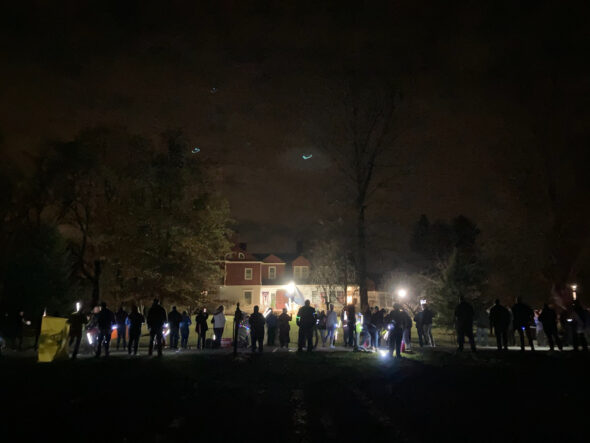
On Friday, Nov. 20, 2020, nearly 200 demonstrators gathered outside Gov. Mike DeWine’s home in Cedarville Township to protest his and the Ohio Department of Health’s COVID-19-related mandates, including the statewide mask order and the 10 p.m. curfew.(Photo by Reilly Dixon)
A return to normal?
As the months went by, and as local residents continued to get vaccinated at regional clinics, wearing masks in public and routinely testing at home for COVID, Yellow Springs gradually returned to a kind of pre-pandemic homeostasis.
One of the earliest signs of a return to normalcy came in May 2021, when local students went back to school for in-person learning — at least part-time, and wearing masks. Not long before, in-person visitation resumed at Friends Care Community.
Most state restrictions on businesses and restaurants were lifted in early summer 2020; but shops, bars, diners and boutiques were nevertheless forced to adapt to the unusual conditions of the pandemic. As previously reported in the News, many business owners said they struggled to weather the pandemic years; money and customers were lost, and COVID-related supply chain disruptions made matters difficult.
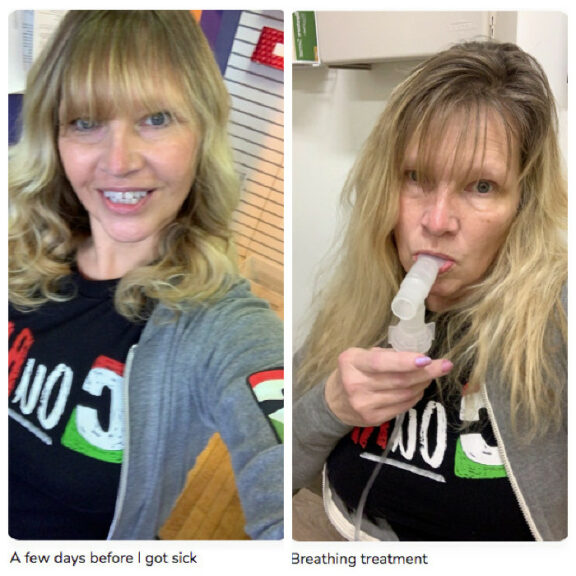
Lisa Watson, a five-year employee of the YS Post Office, documented her journey with long COVID for several months on a blog with both text posts and photos, including the ones displayed here. The photo on the left was taken a few days before Watson began experiencing COVID symptoms; the one on the right — in which Watson is dressed in the same outfit — was taken as Watson received a breathing treatment after being diagnosed with COVID-related pneumonia. (Submitted photos)
“We’re at half capacity. It’s not a typical summer,” Mary Kay Smith, owner of the Winds Cafe, told the News in 2020.
Smith added that her companion business, the Winds Wine Cellar, sold more alcohol than in 2019 — consistent with recent data from the National Institutes of Health that indicates alcohol consumption increased more during the pandemic than in the previous 50 years.
“Everyone has had every part of their apple cart upset,” Christine Monroe-Beard, co-owner of Ye Olde Trail Tavern and Peach’s Grill, said in 2020.
Monroe-Beard and her husband, Don Beard, delayed opening both their restaurants, as well as their Dayton Street shop, the Import House, until that May. When they did, they had a 100% mandatory masking policy for all their customers. She also said that, owing to a fractured supply chain, dairy and meat items were difficult to source reliably.
Plexiglass partitions were installed between tables and booths at most local restaurants, and some places, such as Nipper’s Corner, had signage and arrows that directed customers through the store to avoid close contact. The Emporium kept its main seating area closed and cordoned off with caution tape until February 2022.
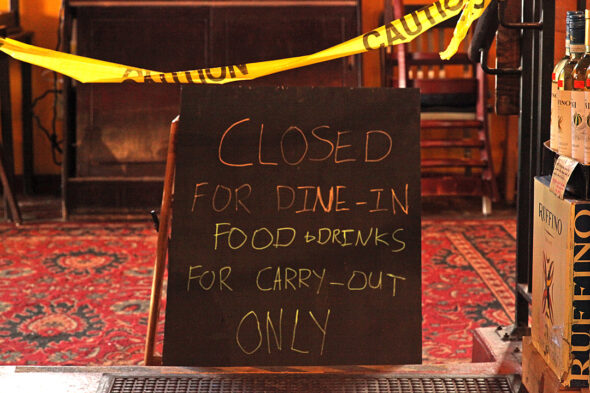
The Underdog Café and Emporium Wines temporarily ceased indoor dining and gathering. (Photo by Ben Guenther.)
Now, most of those COVID-era relics have disappeared.
Five consecutive Street Fairs were canceled, but when the fall event returned in 2022, many thousands of visitors flocked again to Yellow Springs. The Chamber of Commerce told the News afterward that some downtown businesses made record sales.
A relative sense of pre-pandemic normalcy has also returned to the Yellow Springs Senior Center. Last week, groups of seniors were seen unmasked, practicing ukulele, learning Spanish and attending an improv class.
“It’s been interesting to witness from this perspective, because this is a vulnerable population,” Maggie Dean, the activities and volunteer coordinator for the Senior Center told the News earlier this week. “Now, in general, there is an acceptance that this is just how life is going to be.”
Dean said that although the Senior Center no longer requires masking or a mandatory quarantine upon testing positive for COVID-19, the Senior Center still offers some health services such as free testing, masks and more. Members and attendees are still encouraged to follow CDC guidelines and protocol.
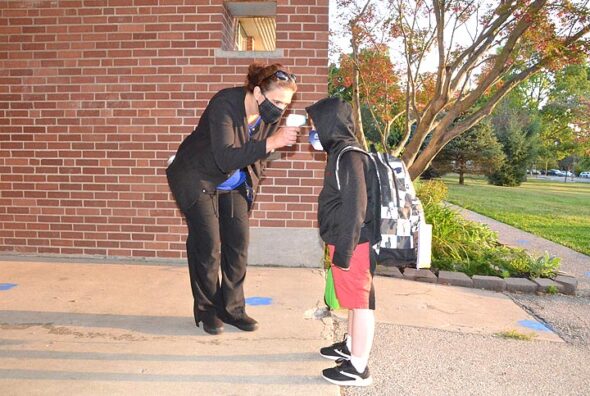
An unidentified student had his temperature taken by school nurse Charlyn Cantrell before entering Mills Lawn School. The district required everyone going into the schools to have a temperature check before entering. (Photo by Carol Simmons)
Meanwhile, effects from the COVID-19 pandemic continue to be felt at the local schools.
Mills Lawn Guidance Counselor John Gudgel told the News this week that the closures and shift to remote learning likely stunted the educational, emotional and social growth of some students.
“Quite a few kids lost a whole year,” Gudgel said. “There’s nothing like face-to-face learning. It’s not just better for education, but it builds social development, too.”
He added: “One positive thing that came from the pandemic, though, is kids are a little more conscious of washing their hands.”
Yellow Springs High/McKinney Middle School Principal Jack Hatert echoed some of Gudgel’s concerns, stating that the pandemic was “certainly a challenge” for the schools, but added that his staff and students have emerged more resilient and cooperative.
“I believe our small size allowed us to pivot and provide a more intentional response than many bigger schools,” Hatert told the News. “The support our families showed our educators during the most trying times will forever be a highlight. We are fortunate to have educators in our community who truly love and care about the students, and approaching them with support and grace goes a long way.
Hatert also said that, as a result of the adaptations that the pandemic necessitated, students and teachers gained a greater facility with technology — and with that, access to more educational opportunities.
“The most lasting impact of this for our students is in their access to online college-level courses through College Credit Plus,” he said. “Pre-pandemic, our students had to drive to local colleges or universities to take courses that worked around their school schedule. Now, they can schedule online courses and work on them from the school or from home, allowing much greater access.”
At the county level, Laurie Fox, public information officer for Greene County Public Health, or GCPH, said she’s proud of how Yellow Springs and the surrounding area weathered the pandemic.
“Hailstorms, tornadoes, pandemics — Greene County knows how to survive just about anything,” Fox told the News. “Through the diligence of science, epidemiologists and healthcare professionals, we learned how to fight and treat this virus. So when there’s another pandemic — which there usually is every 100 years — we’ll know exactly how to learn to survive that one.”
Fox added that although GCPH follows the directives from ODH — that is, currently, to treat COVID-19 with the same degree of caution as RSV and the flu — the county organization will continue to monitor local transmission rates and provide up-to-date information.
“There may be future waves [of COVID-19],” Fox said. “And like the flu, it can still be caught year-round — especially in the winter when all viruses spike. People gather indoors, in enclosed spaces, and viruses love that.”
ED. note: Since the initial outbreak, the News has run regular COVID-19 updates, often in the form of a column featuring the most recent data from the CDC and ODH, and typically on the second-to-last page of each weekly issue. In the event of a significant uptick in COVID cases, hospitalizations or deaths, the News will revive the “COVID-19 Update” column, but as of this issue of the News, the column is being discontinued.
The Yellow Springs News encourages respectful discussion of this article.
You must login to post a comment.
Don't have a login? Register for a free YSNews.com account.

Parkinsons.jpg)



Parkinsons.jpg)
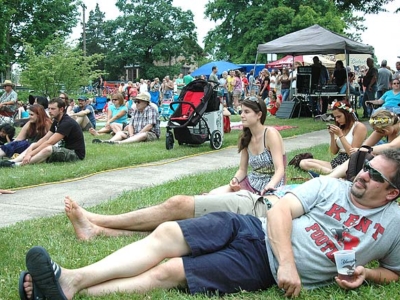










No comments yet for this article.